Understanding
Network Address Translation (NAT)
Network Address Translation (NAT) is a vital networking technique that modifies network address information in packet headers while they transit across a traffic routing device. Public IPs enable access to the Internet and can be routed worldwide, whereas Private IPs are restricted to internal networks and cannot be routed over the Internet. NAT facilitates the utilization of a single Private IP Address numerous times within our networks while still granting access to the Internet. Essentially, NAT serves as a bridge between Private and Public IP Addresses. We connect to the Internet using our Private IP, while in the background, our router communicates with the Internet using a Public IP.
NAT doesn’t only translate Private IPs to Public ones; it also manages translations between Public IPs or even between Private IPs. However, the most common application involves translating Private to Public IPs.
NAT operates at the network layer (Layer 3) of the OSI model and is primarily implemented in routers, gateways, and firewalls.
Purpose of NAT:
NAT primarily aims to conserve public IP addresses, which are limited and valuable. It achieves this by allowing multiple devices within a private network to share a single public IP address, enabling collective Internet access. This is especially critical when the number of devices surpasses the available public IP addresses.
Additionally, NAT serves a vital role in network security. It enables the concealment of your network from external sources. Through various NAT configurations, remote nodes connecting over the Internet only perceive your Public IP Address, without any knowledge of your local Private IP Addresses.
NAT Terminology:
When we talk about NAT (Network Address Translation), there are four main terms you’ll often come across:
Inside Local IP Address: This refers to the original IP address of a device within your local network before any translation occurs. It’s like your computer’s address within your home network.
Inside Global IP Address: After the translation process, this is the IP address your device appears to have outside of your local network. It’s the address seen by devices on the internet.
Outside Global IP Address: This is the original IP address of a device outside of your local network before translation. For example, it could be the IP address of a website’s server.
Outside Local IP Address: After translation, this is the IP address of a device outside your local network as it appears within your local network. For instance, it could be the IP address of a website’s server as seen from within your home network.
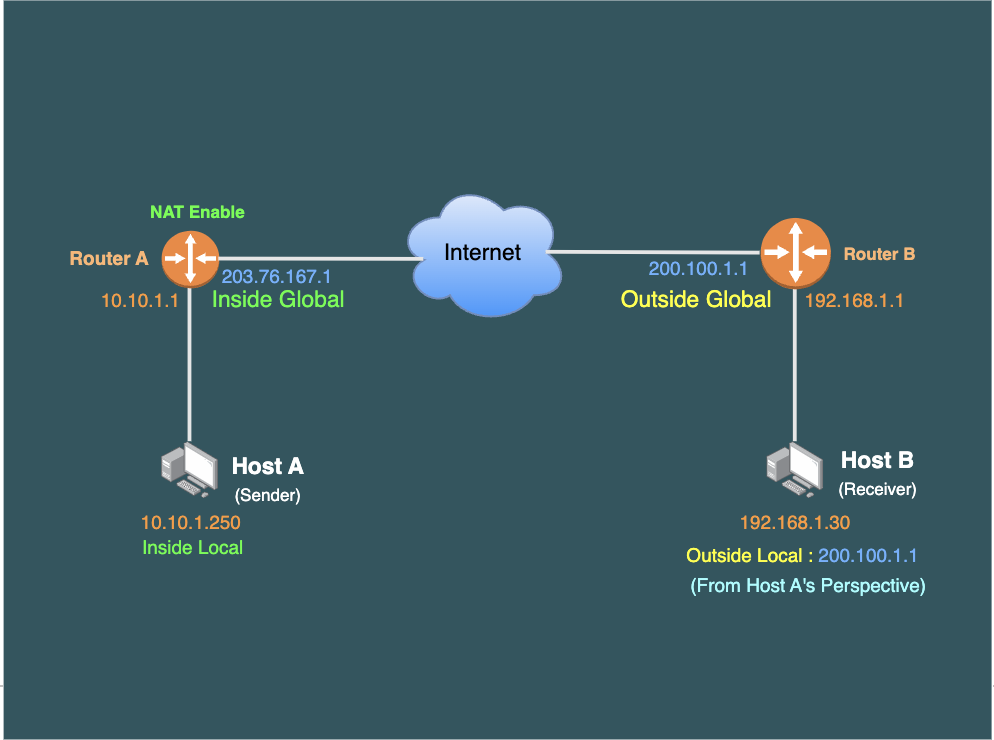
Let’s break down the NAT terms using the example provided, focusing on Host A’s perspective:
Inside Local Address (Host A): This is the private IP address assigned to Host A within its local network. In this case, it’s 10.10.1.250. Host A uses this address to communicate within its local network.
Inside Global Address (Host A): When Host A communicates outside its local network, it uses Router A’s public IP address, which is 203.76.167.1. This address is used to communicate with devices on the internet.
Outside Global Addresses (Router B): The IP addresses assigned to Router B is considered outside global address. In this example, 200.100.1.1 is the outside global. This address is visible to devices outside their local network.
Outside Local Address (Host B from Host A’s perspective): Host B, located in another network, has a private IP address within its local network. However, from Host A’s viewpoint, Host B’s global IP address, which is 200.100.1.1, is considered an outside local address. This is because it’s the address Host A sees for communicating with Host B over the internet.
In summary:
- Inside Local Address: 10.10.1.250
- Inside Global Address: 203.76.167.1
- Outside Global Address: 200.100.1.1
- Outside Local Address: 200.100.1.1
Types of NAT:
Following are the common types of NAT serve distinct purposes in networking environments:
Static NAT:
Also known as one-to-one NAT, it maps a single private IP address to a corresponding public IP address. This type of NAT is typically used when a device within the private network requires constant accessibility from the Internet, such as a web server or a mail server.
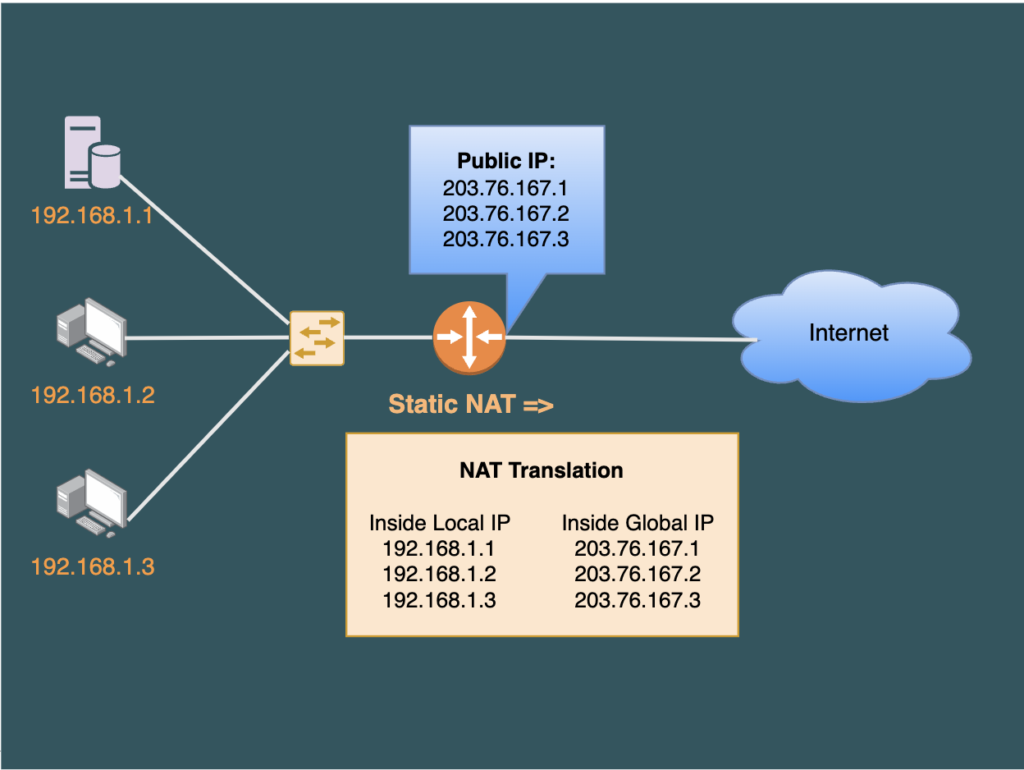
In the example provided above, we can observe that each private IP address is mapped to a particular public IP address. For instance, the private IP address 192.168.1.1 is associated with the public IP address 203.76.167.1
Dynamic NAT:
Dynamic NAT dynamically maps private IP addresses to public IP addresses from a pool of available addresses. It allows multiple devices within the private network to access the Internet simultaneously, each using a unique public IP address from the pool.
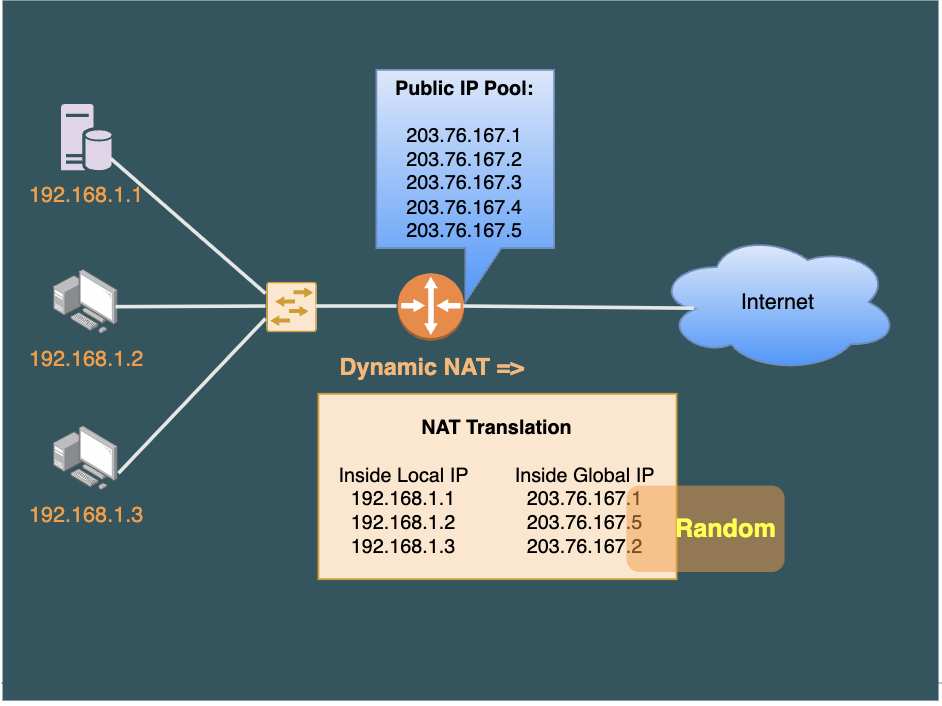
In the scenario described, each private IP address is assigned a specific public IP address from a pool of public IPs. The assignment of public IP addresses to private ones is done randomly. For instance, the private IP address 192.168.1.2 might be assigned to the public IP address 203.76.167.5.
Port Address Translation (PAT):
Also referred to as NAT Overload, PAT maps multiple private IP addresses to a single public IP address by using different source port numbers to distinguish between connections. It is the most common type of NAT used in residential and small business environments.
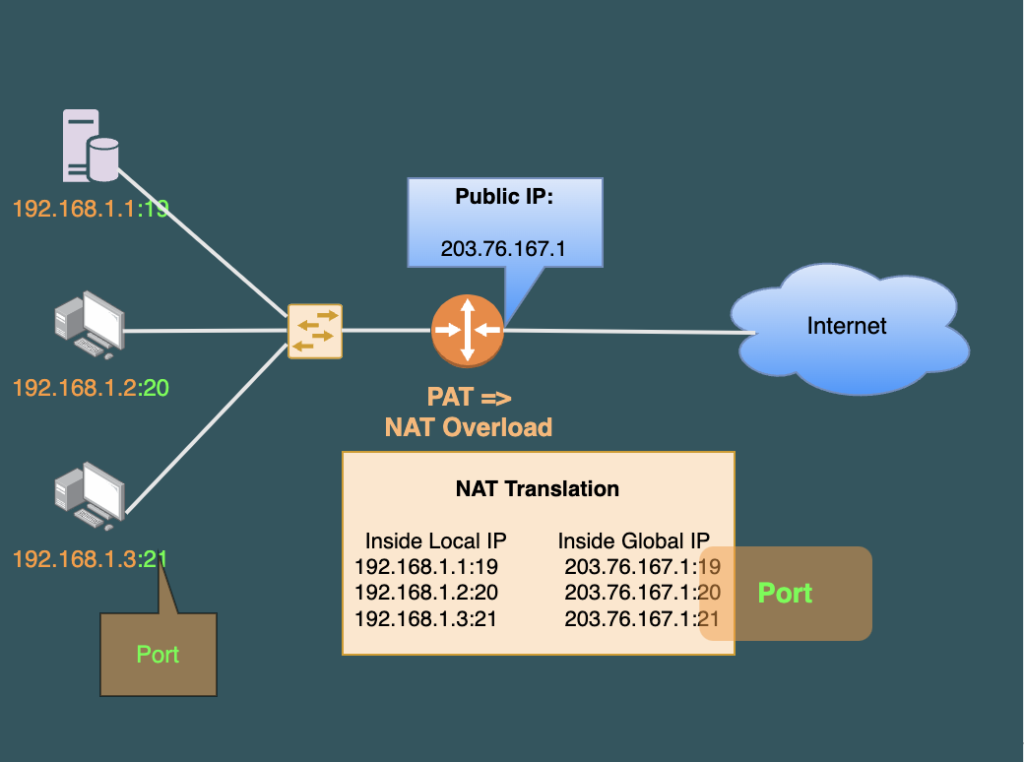
In the given example, private IP addresses are translated to specific public IP addresses using port numbers. For instance, the private IP address 192.168.1.3, associated with port number 21, is translated to the public IP address 203.76.167.1, also using port number 21.
Key Components of NAT
The process of NAT involves several key components and steps:
- Translation Table: NAT devices maintain a translation table that records mappings between private IP addresses and corresponding public IP addresses or port numbers. This table is crucial for tracking active connections and ensuring proper routing of packets using routing table.
- Packet Modification: When a packet traverses a NAT device, the device modifies the packet header to replace the source IP address and port (in the case of PAT) with the public IP address and a unique port number. This alteration enables the packet to traverse the public Internet while preserving the original private addressing scheme within the private network.
- Session Tracking: NAT devices track the state of each network connection to manage incoming and outgoing traffic effectively. This involves monitoring the source and destination IP addresses, ports, and protocol types to maintain accurate translation mappings.
- Address Allocation: In dynamic NAT and PAT configurations, NAT devices allocate public IP addresses and port numbers from predefined pools as needed. This allocation process ensures efficient utilization of available resources while preventing conflicts between concurrent connections.
Benifits & Functionality of NAT
NAT offers several benefits and functionalities:
- Address Conservation: By allowing multiple devices to share a single public IP address, NAT helps conserve public IP address space, which is particularly valuable in the face of IPv4 address exhaustion.
- Enhanced Security: NAT acts as a barrier between the private network and the Internet, hiding internal IP addresses and making it more challenging for malicious actors to directly target devices within the network.
- Simplified Network Management: NAT simplifies network configuration by reducing the dependency on globally unique IP addresses for internal devices. Administrators can design and manage private networks with greater flexibility and scalability.
- Protocol Interoperability: NAT can facilitate the coexistence of different network protocols, such as IPv4 and IPv6, by translating between incompatible address formats. This interoperability is crucial during the transition from IPv4 to IPv6.
Limitations of NAT
Despite its widespread adoption and benefits, NAT also presents some limitations and challenges:
- Impact on Peer-to-Peer Applications: NAT can hinder the performance and functionality of peer-to-peer applications that rely on direct communication between devices. These applications often encounter difficulties due to the translation of IP addresses and port numbers.
- Complexity in Configuration: Configuring and managing NAT configurations, particularly in large-scale deployments, can be complex and error-prone. Maintaining translation tables and addressing conflicts requires careful planning and monitoring.
- Potential for Address Exhaustion: While NAT mitigates the immediate pressure of IPv4 address exhaustion, it does not provide a long-term solution. As the demand for Internet-connected devices continues to grow, NAT may eventually face limitations in addressing the scalability requirements of modern networks.
In conclusion, Network Address Translation (NAT) is a vital networking technique that enables the efficient utilization of public IP addresses and facilitates connectivity between private networks and the Internet. Despite its inherent limitations, NAT remains a cornerstone of modern network infrastructures, providing a balance between address conservation, security, and interoperability. As networking technologies evolve, NAT will continue to adapt to meet the changing demands of global connectivity.


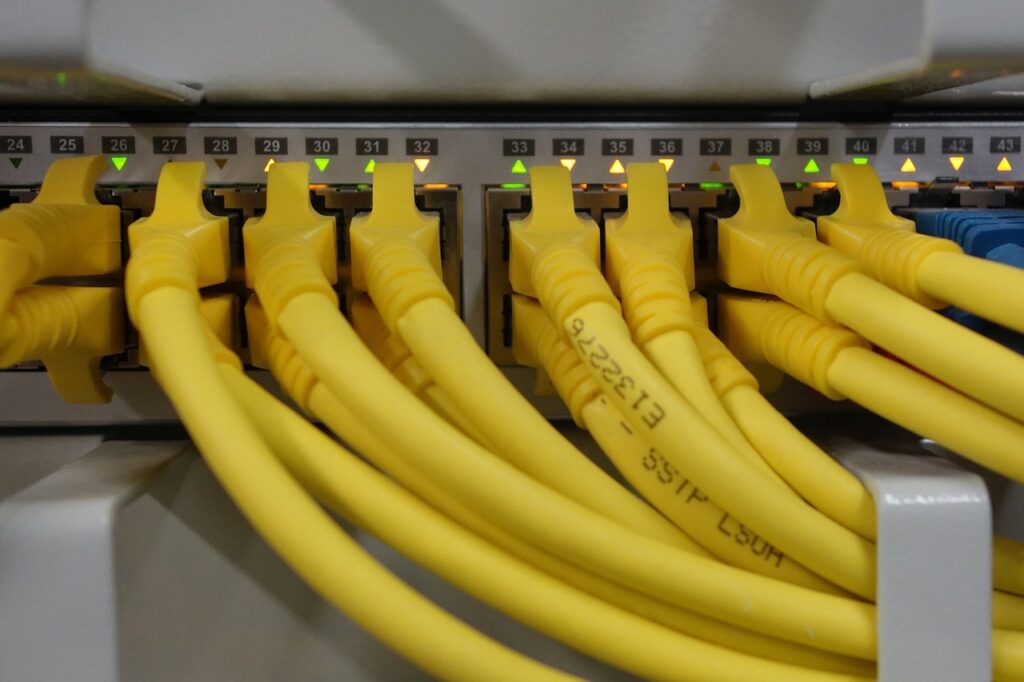


This is really helpful for me